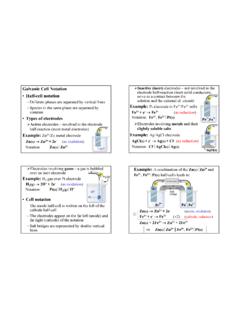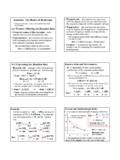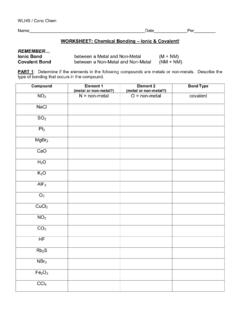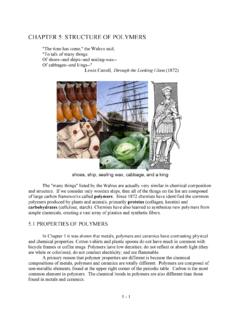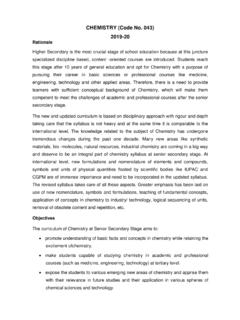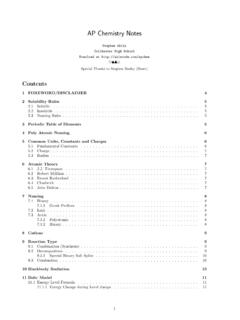Transcription of 2.6 Elements and the Periodic Table • Elements in a group ...
1 Elements and the Periodic Table Elements in a group have similar properties Periodicity in the properties of the Elements Elements in a period have different properties Mendeleev's Table , 1871 arrangement by Metals atomic mass good electrical and heat conductivity, malleable, Modern version of the Table arrangement by ductile atomic number Groups vertical columns in the Table Nonmetals A groups (1, 2, 13-18) representative Elements poor electrical and heat conductivity, neither malleable nor ductile, often gases or liquids B groups (3-12) transition Elements Inner transition Elements lanthanides & Metalloids actinides semiconductors, intermediate properties Periods horizontal rows in the Table Properties change gradually down in a group group 1A (1) - alkali metals (Li, Na, K, Rb.)
2 Soft, easy melting metals; react violently with water reactivity increases down in the group group 2A (2) - alkaline earth metals (Be, Mg, ..). similar but less reactive than group 1. reactivity increases down in the group group 7A (17) - halogens (F, Cl, Br, I,..). very reactive - reactivity increases up in the group gradual change in physical properties - F, Cl (yellow gases), Br (red-brown liquid), I (purple-black solid). group 8A (18) - noble gases (He, Ne, Ar,..). very low reactivity - inert gases colorless, odorless gases 1. Compounds ionic compounds consist of positive and Combination of two or more Elements in negative ions held together by electrostatic some definite proportion attraction (NaCl, CaO, ..). Chemical bonds the forces that hold the Positive ions (cations) often produced when atoms of Elements together in compounds metals lose electrons (Na+, Ca2+.)
3 ionic bonding results from transfer of Negative ions (anions) often produced when electrons from one atom to another nonmetals gain electrons (Cl-, O2-, ..). Covalent bonding results from sharing of Binary ionic compounds composed of just electrons between atoms 2 Elements (typically a metal and a nonmetal). Ions el. charged atoms or groups of atoms Monatomic ions formed through gain or Molecules el. neutral groups of atoms loss of e- by single atoms covalently bonded together Formation of binary ionic compounds Charges of monoatomic Example: NaCl ions can be predicted The electrons lost by Na are gained by Cl from the Periodic Table Typically metals loose e- and nonmetals gain e- until they reach the same number of e- as in the nearest noble gas (high stability).
4 Groups 1A 3A form cations with charges equal to the group # (only the lighter members of 3A). Groups 5A 7A - anions with charges equal to the group # - 8 (only the lighter members of 5&6A). 2. The strength of ionic bonds depends on the Problems: charges and sizes of the ions 1. What are the charges of the monatomic Potential energy of interaction between two ions ions formed by Al and Br? with charges q1 and q2 separated by a distance r12 Al group 3A 3+ Al3+. q1 q2 (loss of 3e- Ne). Ep =. r12 Br group 7A 7 8 = -1 Br- Ions with higher charges and smaller sizes (gain of 1e- Kr). attract each other stronger ionic compounds are neutral the # of 2. What is the ratio of Al3+ to Br- ions in the binary ionic compound of these Elements ? positive charges must equal the # of negative charges (charge balance) Al3+ : Br- 1:3 1(+3) + 3(-1) = 0.
5 Covalent compounds typically consist of Mixtures molecules in which atoms are bonded Contain more than one pure substances together through sharing of electrons Heterogeneous mixtures - composition molecular compounds (H2O, NH3, ) changes from one part to another (soil, blood, Formed usually between nonmetals milk, dust, fog, ..). Some Elements occur in nature in a molecular Homogeneous mixtures - composition is form (H2, O2, N2, F2, Cl2, Br2, I2, P4, S8, ) uniform throughout (sea water, air, gasoline, Polyatomic ions consist of two or more vinegar, brass, ..). covalently bonded atoms with a net overall Solutions - homogeneous mixtures charge (NH4+, SO42-, ) participate in solvent - present in the larger amount ionic bonding solute - the dissolved substance Aqueous solutions - the solvent is water 3.
6 Differences between mixtures and Distillation - compounds differences in the volatility (boiling point). Separation of mixtures (relies on differences in the physical properties of the components). Extraction - differences in the solubility Filtration - differences in particle size Chromatography - differences in the ability to adsorb on surfaces or absorb into liquids Stationary and mobile phases GC. LC. 4.
